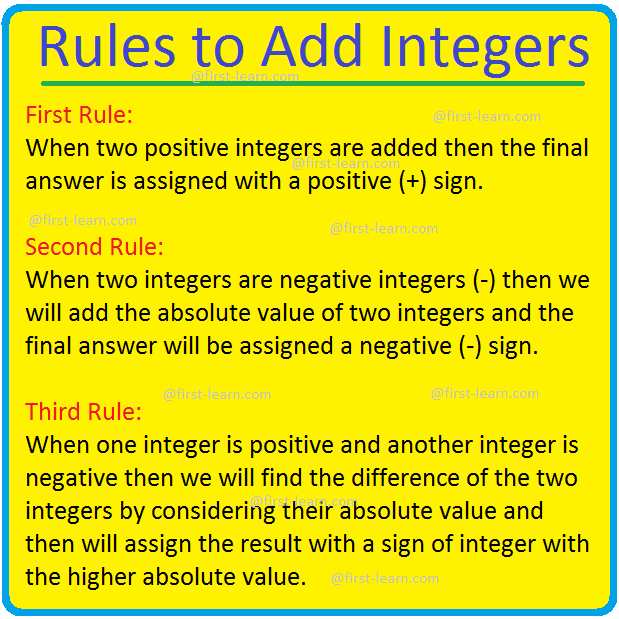Rules to Add Integers
Integers are positive, negative numbers including zero and do not include any fractional part. This topic will cover the rules for adding integers. There are certain rules which will help us in understanding how:
- Two positive integers are added
- Two negative integers are added
- One positive and another negative integers are added
First Rule:
When two positive integers are added then the final answer is assigned with a positive (+) sign
For Example:
(i) 8 + 9 = 17
Here 8 and 9 both are positive integers and they are added to get 17.
(ii) 25 + 30 = 55
Here 25 and 30 both are positive integers and they are added to get 55
(iii) 80 + 10 = 90
Here 80 and 10 both are positive integers and they are added to get 90
(iv) 30 + 10 = 40
Here 30 and 10 both are positive integers and they are added to get 40
Second Rule:
When two integers are negative integers (-) then we will add the absolute value of two integers and the final answer will be assigned a negative (-) sign.
For example:
(i) (-8) + (-5) = -13
Here both the integers are negative i.e. – 8 and – 5. So we will add their absolute value that is 8 and 5 which adds to 13. Now since both the numbers are negative so the answer will also carry a negative sign.
(ii) (-6) + (-6) = - 12
Here both the integers are negative i.e. – 6 and – 6. So we will add their absolute value that is 6 and 6 which adds to 12. Now since both the numbers are negative so the answer will also carry a negative sign.
(iii) (-5) + (-2) = -7
Here both the integers are negative i.e. – 5 and – 2. So we will add their absolute value that is 5 and 2 which adds to 7. Now since both the numbers are negative so the answer will also carry a negative sign.
(iv) (-7) + (-3) = -10
Here both the integers are negative i.e. – 7 and – 3. So we will add their absolute value that is 7 and 3 which adds to 10. Now since both the numbers are negative so the answer will also carry a negative sign.
Third Rule:
When one integer is positive and another integer is negative then we will find the difference of the two integers by considering their absolute value and then will assign the result with a sign of integer with the higher absolute value.
For Example:
(i) 4 + (-7) = -3
Here the first number is positive i.e. 4 and the second number is negative i.e. – 3. We know from the rule that when one integer is positive and another negative then we have to find the difference between those two integers by considering their absolute value. Hence 7 – 4 = 3, but the integer with higher absolute value is 7. Hence the result 3 will have negative (-) sign i.e. – 3.
(ii) (-8) + 2 = -6
Here the first number is negative i.e. – 8 and the second number is positive i.e. +2. We know from the rule that when one integer is positive and another negative then we have to find the difference between those two integers by considering their absolute value. Hence 8 – 2 = 6, but the integer with higher absolute value is 8. Hence the result 6 will have negative (-) sign i.e. – 6.
(iii) (-5) + 10 = + 5
Here the first number is negative i.e. – 5 and the second number is positive i.e. +10. We know from the rule that when one integer is positive and another negative then we have to find the difference between those two integers by considering their absolute value. Hence 10 – 5 = 5, but the integer with higher absolute value is 10. Hence the result 5 will have positive (+) sign i.e. + 5.
From Rules to Add Integers to HOME PAGE
Recent Articles
-
What Is Plasma? | Blood Plasma | Proteins | Nutrients | Cholesterol
Nov 07, 25 10:29 AM
Blood is a mobile fluid which is a connective tissue and is derived from the mesoderm like cell any other connective tissue. Colour of blood is reddish and that flows inside the blood vessels by means… -
Disorders of Respiratory System | Tuberculosis | Pleurisy | Emphysema
Oct 28, 25 11:39 PM
Tuberculosis is very common disease and is caused by a type of bacteria called Mycobacterium tuberculosis. This disease causes different trouble in the respiration and infection of several parts of th… -
Regulation of Respiration | Respiratory Centres | Inspiratory Area |
Oct 14, 25 12:13 AM
Respiratory Centre is the area that controls the rate of respiration and it is observed to be located in medulla oblongata and pons. Respiratory Centre has the following will dispersed components like… -
Explain Transport of Gases | External Respiration | Tissue Respiration
Oct 09, 25 11:35 PM
In humans gaseous exchange is completed in the following ways the steps are - External Respiration or Breathing - Breathing in false taking in of Oxygen and giving out of carbon dioxide in the body. M… -
Kind and Number of Teeth | Location of Teeth in Mouth | Care of Teeth
Sep 11, 25 12:52 AM
Kind and Number of Teeth







New! Comments
Have your say about what you just read! Leave me a comment in the box below.